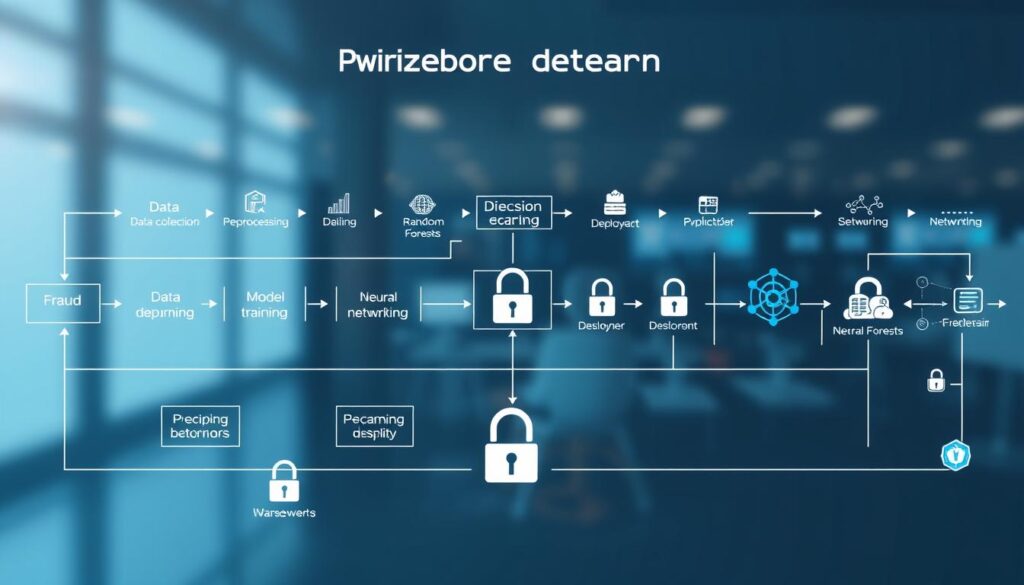Now Reading: Machine Learning Crypto Rug Pull Detection Explained
- 01
Machine Learning Crypto Rug Pull Detection Explained
Machine Learning Crypto Rug Pull Detection Explained

The world of digital assets offers incredible opportunities, but it also harbors significant risks. One of the most damaging threats to investors is the sudden collapse of a new token, often referred to as a scam. These events can wipe out investments in moments.
These fraudulent schemes represent a massive problem. They account for over a third of all scam revenue in the digital currency space. This results in nearly $3 billion in annual losses for investors globally.
Fortunately, new technologies are emerging to fight back. Advanced analytical frameworks can now identify warning signs of a potential scam with remarkable speed. Some methods achieve high accuracy by analyzing data from just the first five minutes of a token’s trading activity.
This guide will explore how these intelligent systems work. We will explain how they process trading patterns and liquidity data to spot fraud before major financial damage occurs. Understanding these tools is becoming essential for modern investors.
Key Takeaways
- Fraudulent token scams are a severe threat, causing billions in investor losses annually.
- Advanced analytical technologies can identify potential scams extremely early.
- Some detection methods analyze data from the first few minutes of trading.
- These systems achieve high accuracy by examining liquidity and trading behavior.
- Early warning systems are crucial for protecting investments in the digital asset space.
- This technology has evolved from research to practical use on major blockchain networks.
Introduction to Machine Learning in Crypto Security
Modern blockchain ecosystems face a critical security dilemma with massive user growth. The TON network saw monthly active users reach 4.64 million. Many new participants lack awareness of blockchain risks.
Overview of Crypto Rug Pulls
These fraudulent schemes exploit decentralized platforms. Developers create seemingly legitimate projects. They attract funds through hype and promises.
Then they suddenly abandon the project or drain liquidity pools. DeFi ecosystems remain particularly vulnerable to these sophisticated fraud schemes.

Importance of Early Fraud Detection
Timing proves crucial for protecting investments. Research shows nearly half of scam tokens vanish within four hours of launch. This creates extremely narrow windows for investor protection.
Advanced analytical frameworks process vast blockchain data in real-time. They identify suspicious patterns in liquidity movements and trading behaviors. These systems provide crucial reference tools during critical early stages.
The technology has evolved from academic research to practical use. Modern detection methods offer pattern recognition that human analysis cannot match. Investors gain essential protection through these intelligent security systems.
Understanding Crypto Rug Pulls
Investors navigating token markets must contend with carefully orchestrated schemes designed to drain value from projects. These fraudulent operations exploit the decentralized nature of digital asset platforms.
Definition and Common Scam Methods
A rug pull occurs when project creators suddenly abandon their venture after raising capital. This leaves participants holding worthless assets. Different variations of this scam exist with distinct mechanics.
Hard pulls involve malicious code embedded in smart contracts. This allows creators to withdraw liquidity at will or prevent investor sales. Soft pulls see gradual abandonment after insiders sell their holdings.
Liquidity removal schemes build trading pairs to create legitimacy. Scammers then drain the pools completely. Dumping operations coordinate massive sell-offs after artificial price inflation.

Real-World Examples in DeFi
The Mantra case demonstrated the massive scale possible with these operations. Losses reached $5.52 billion in 2024, affecting countless participants.
Research reveals alarming patterns in token creation. About 70% of addresses launch only one project before disappearing. Nearly half of suspicious assets vanish within four hours of launch.
These statistics highlight the critical need for thorough due diligence before investing. Understanding scam mechanics helps identify warning signs early.
Role of Machine Learning in Detecting Scams
Intelligent systems are fundamentally changing how we approach security in the digital asset space. These frameworks process information at a scale and speed impossible for manual review.
They examine multiple streams of information simultaneously. This includes transaction histories, liquidity pool changes, and social media sentiment. By combining these sources, they build comprehensive risk profiles for new projects.

Two primary methods drive this analysis. Supervised learning trains models on historical data of both legitimate and fraudulent projects. This teaches the system to recognize characteristic patterns.
Unsupervised techniques, however, look for anomalies. They identify unusual behavior that doesn’t match any known patterns. This is crucial for spotting novel scam variants.
Natural language processing adds another layer. It scans text from forums and announcements for linguistic clues associated with fraud. This includes excessive hype or vague promises.
| Method | Primary Function | Key Strength | Data Input |
|---|---|---|---|
| Supervised Learning | Pattern Recognition | High accuracy on known scam types | Historical transaction data |
| Unsupervised Learning | Anomaly Detection | Identifies novel, evolving threats | Real-time trading behavior |
| Natural Language Processing | Sentiment & Hype Analysis | Assesses project communication tone | Social media, project announcements |
Ensemble methods combine the power of different algorithms. This approach often achieves higher detection accuracy than any single model. It leverages the strengths of various techniques like decision trees and gradient boosting.
The ultimate advantage is real-time processing. These systems monitor blockchain activity continuously. They provide instant alerts during the critical first minutes a token trades on platforms.
This technology doesn’t just automate old methods. It discovers entirely new fraud indicators through advanced data analysis.
How to Implement Machine Learning for Rug Pull Detection
The practical application of analytical security systems involves a multi-stage workflow. This process transforms raw blockchain information into a powerful protective tool.
Frameworks and Algorithms Overview
Several powerful models have proven effective for this task. Gradient Boosting frameworks like XGBoost and LightGBM often deliver top performance.
Random Forests and neural networks are also valuable. Ensemble methods combine these algorithms for even greater accuracy.

| Framework Type | Primary Use Case | Performance Strength |
|---|---|---|
| Gradient Boosting (XGBoost) | High-precision pattern recognition | Excels with structured tabular data |
| Random Forest | Robust anomaly identification | Handles noisy data effectively |
| Neural Networks | Complex pattern discovery | Adapts to novel scam strategies |
| Ensemble Methods | Combining multiple model strengths | Achieves highest overall accuracy |
Step-by-Step Implementation Guide
First, collect comprehensive data from blockchain explorers and DEX APIs. This includes transaction histories and liquidity pool details for new tokens.
Preprocessing cleans this raw information. It handles missing values and normalizes scales. This step is crucial for model training.
Next, generate meaningful features like price volatility and holder concentration. These variables help the system identify risky patterns.
Finally, label historical tokens and train the selected models. Continuous evaluation ensures the system adapts to new threats.
Machine Learning Crypto Rug Pull Detection Methods
Security frameworks utilize contrasting definitions to capture different types of investment threats. Each method targets specific fraudulent behaviors with mathematical precision.
TVL-Based Approach Explained
The TVL method identifies schemes through catastrophic liquidity withdrawal. It flags events where Total Value Locked drops over 99% from peak levels within the first hour.
This approach directly measures the most obvious scam signal—developers draining funds from pools. The $UKWNPTHS token demonstrated this pattern when its value collapsed from $300,000 to just $1.
Idle Approach Explained
The idle method detects abandonment through complete trading cessation. It identifies tokens with zero buy/sell activity for one hour after launch.
This strategy has practical value since assets without market movement become unsellable. The $NOOB token showed this pattern with three quick trades followed by total inactivity.
Research shows TVL-based detection achieves higher overall accuracy (AUC 0.891). The idle method provides superior recall for subtler abandonment patterns.
Data Collection and Mining Techniques
Accurate threat identification requires systematic collection of trading and liquidity information across multiple platforms. High-quality data forms the essential foundation for reliable security assessments.
Gathering Trading and Liquidity Data
Services like Dune.com provide access to indexed blockchain data. The TON Foundation offers structured information with all transactions and events available in open-source databases.
Specialized SQL queries extract detailed records from tables like ton.dex-trades and ton.dex-pools. This ensures comprehensive coverage of trading activity and liquidity movements.
Platform selection focused on the largest decentralized exchanges by volume. Ston.Fi and DeDust were chosen as the most representative venues for analysis.
The dataset includes thousands of tokens with complete pool details and non-zero transaction values. Careful filtering removes incomplete records that could reduce model performance.
This approach captured 99.4% of platform activity within the specified timeframe. Quality data collection enables effective pattern recognition for security purposes.
Feature Engineering and Data Preprocessing
Transforming raw blockchain records into actionable intelligence requires sophisticated data transformation techniques. This process converts millions of transactions into meaningful patterns that security systems can analyze effectively.
Constructing Key Features for Analysis
Engineers create several feature categories for each digital asset. Transaction features track trade counts, volume metrics, and buy/sell ratios. Price features measure volatility and stability indicators.
Liquidity features monitor pool depth changes and withdrawal patterns. Time-based features capture activity gaps and trading hour distributions. Meta-features analyze holder concentration and wallet behaviors.
These variables help identify normal versus suspicious activity. Most features show right-skewed distributions where few assets demonstrate high values. This pattern is typical for financial data analysis.
The same feature sets work across different platforms. However, underlying statistical distributions vary significantly between exchanges. This challenges straightforward data fusion approaches.
Platform-aware models must account for these distribution differences. Continuous refinement occurs based on performance feedback. This iterative process optimizes detection accuracy over time.
Evaluating Detection Models
The validation process for analytical security systems relies on standardized metrics that determine real-world reliability. These measurements help investors understand which frameworks provide genuine protection.
Performance Metrics: AUC, Precision, Recall
AUC measures how well systems rank risky assets above safe ones. Scores near 1.0 indicate excellent discrimination capability.
Precision focuses on warning reliability. High precision means alerts are usually correct, building investor trust.
Recall captures the percentage of actual threats identified. This prevents dangerous assets from slipping through unnoticed.
Challenges and Optimization Strategies
Class imbalance presents a major challenge. Legitimate tokens vastly outnumber fraudulent ones in training data.
Optimization strategies include synthetic data generation and careful threshold selection. Continuous retraining adapts to new threat patterns.
Comparative Analysis of Approaches
TVL-based methods achieve superior overall accuracy with AUC scores reaching 0.891. They excel at identifying liquidity withdrawal schemes.
Idle-based approaches provide better recall for abandonment patterns. This analysis helps choose the right tool for specific protection needs.
Exploring TVL and Idle Based Detection Strategies
Security frameworks employ fundamentally different approaches to identify fraudulent token behaviors. Each method targets specific patterns that indicate potential investment risks.
The TVL-based approach focuses on liquidity catastrophes. It identifies when Total Value Locked drops over 99% within the first hour. This method catches explicit theft where developers drain pools.
This strategy achieves higher overall accuracy with AUC scores reaching 0.891. It works best for hard fraud schemes involving direct liquidity removal.
The idle-based approach detects complete trading cessation. It flags tokens with zero activity for one hour after launch. This indicates abandonment rather than explicit theft.
This method excels at recall for subtle fraud patterns. It catches scenarios where assets become unsellable through neglect. The strategy complements TVL detection for comprehensive coverage.
Both approaches predict problems within the first hour. They analyze only the first five minutes of trading data. This provides crucial early warning windows for investors.
Understanding these strategies helps choose the right protection tool. TVL methods suit obvious theft cases. Idle methods work for abandonment scenarios.
Data Fusion Strategies for Enhanced Detection
Building truly robust security systems requires combining information from multiple sources. This process, known as data fusion, creates more reliable and generalizable analytical frameworks. By integrating insights from various decentralized exchanges, these systems gain a broader view of market behavior.
Researchers tested five distinct approaches to merging data from different platforms. Each method offers unique advantages depending on the available information and desired outcome.
| Approach Number | Training Strategy | Testing Strategy | Primary Use Case |
|---|---|---|---|
| 1 | Train on Ston.Fi sample | Test on Ston.Fi | Single-platform optimization |
| 2 | Train on DeDust sample | Test on DeDust | Single-platform optimization |
| 3 | Train on combined Ston.Fi & DeDust | Test on either platform | General multi-platform use |
| 4 | Train on Ston.Fi, then retrain on DeDust | Test on DeDust | Transfer learning adaptation |
| 5 | Train on DeDust, then retrain on Ston.Fi | Test on Ston.Fi | Transfer learning adaptation |
Cross-DEX Data Fusion Techniques
A critical discovery emerged from this analysis. Even with identical feature sets, the statistical distributions of data differ greatly between exchanges like Ston.Fi and DeDust.
This phenomenon, called domain shift, means models trained on one platform may perform poorly on another. User behaviors and trading patterns are unique to each environment.
Benefits of Multi-Platform Analysis
Despite the challenge of domain shift, multi-platform analysis offers significant benefits. It exposes security models to a wider variety of fraudulent patterns.
This leads to systems that can identify threats across different types of tokens and market conditions. The result is a more adaptable and powerful protective tool for investors.
Tools and Technologies for Monitoring DeFi Scams
Several specialized platforms now offer real-time surveillance capabilities for digital asset investments. These security tools provide immediate visibility into potential risks across decentralized exchanges.
Investors can access comprehensive scanning systems that analyze multiple risk factors simultaneously. These platforms combine various technologies to create robust protection frameworks.
Blockchain Explorers and Liquidity Scanners
Services like GeckoTerminal aggregate data from multiple decentralized exchanges. They monitor liquidity lock status and holder distribution patterns.
Blockchain explorers such as Etherscan and BscScan allow deep inspection of smart contracts. Users can verify transaction histories and token movement details.
Advanced scanning tools specifically check whether developer tokens have time-locked positions. This reduces the risk of sudden liquidity withdrawal.
| Tool Category | Primary Function | Key Features | Best For |
|---|---|---|---|
| DEX Scanners | Real-time liquidity monitoring | Pool status, volume alerts, holder analytics | Immediate risk assessment |
| Blockchain Explorers | Smart contract verification | Code inspection, transaction history, wallet tracking | Deep technical analysis |
| AI Security Platforms | Automated risk scoring | Contract safety scores, pattern recognition | Comprehensive due diligence |
| Comprehensive Analytics | Multi-dimensional assessment | Team verification, sentiment analysis, historical patterns | Holistic investment research |
AI-powered platforms like Token Sniffer automatically analyze smart contract code quality. They identify potential vulnerabilities and suspicious function implementations.
Comprehensive tools such as Token Metrics evaluate multiple dimensions including team background and community sentiment. These security platforms provide holistic risk scores for informed decision-making.
Practical Tips for Investors to Avoid Rug Pulls
Protecting your capital in the token space requires proactive steps before committing funds. While advanced systems provide warnings, individual due diligence remains your first line of defense against potential losses.
A thorough pre-investment checklist helps separate legitimate ventures from risky ones. This process involves verifying multiple aspects of a venture’s foundation.
Pre-Investment Research and Verification
Always start with deep investigation into the team behind a venture. Legitimate founders have verifiable professional histories and public social media profiles.
Anonymous teams present substantially higher risks. Check their track record on platforms like LinkedIn.
Next, analyze the tokenomics carefully. Look for red flags like excessive allocations to developer wallets. A lack of clear vesting schedules is another warning sign.
Healthy community engagement is a positive indicator. Active forums on Discord or Telegram with transparent communication suggest a genuine project.
Using Trusted Tools and Audits
Independent security audits by firms like CertiK or Hacken are crucial. They review smart contract code for vulnerabilities.
Verify that liquidity pools are time-locked using tools like GeckoTerminal. This prevents developers from withdrawing funds suddenly.
Start with small test investment amounts before committing more capital. This strategy limits exposure if issues arise later.
| Research Area | Key Verification Steps | Red Flags to Avoid |
|---|---|---|
| Team Background | Verify identities on professional networks | Anonymous developers, no public history |
| Tokenomics | Check distribution and vesting schedules | Concentrated holdings, no lock-up periods |
| Security Audit | Confirm third-party code review | No audit or unverified audit report |
| Liquidity Status | Verify pool lock using scanner tools | Unlocked pools, short lock durations |
Diversify your holdings across multiple ventures to spread risk. Be especially skeptical of promises for unrealistic returns.
This careful approach helps investors make informed decisions and protect their capital effectively.
Future Trends in Crypto Security and Detection
Predictive analytics and community-driven vigilance are becoming essential components of modern cryptocurrency defense strategies. The digital asset landscape continues to evolve at a rapid pace.
Memecoins demonstrated explosive growth in 2024, expanding by 330% to reach a $140 billion market. This created new opportunities but also attracted sophisticated fraudulent schemes.
Integration between blockchain platforms and social networks introduces millions of new users. Many lack awareness of digital asset risks. This expansion demands more advanced protective measures.
Future security systems will leverage unsupervised pattern recognition. They analyze vast amounts of data to identify emerging threats before attacks occur. Natural language processing scans social media for manipulation campaigns.
| Approach Type | Primary Function | Key Advantage | Implementation Timeline |
|---|---|---|---|
| Predictive Analytics | Proactive threat identification | Flags risks during development phase | Near-term (1-2 years) |
| Decentralized Reputation | Community-driven warning systems | Distributed intelligence network | Medium-term (2-3 years) |
| Regulatory Frameworks | Legal standards for DeFi platforms | Reduces anonymity advantages | Long-term (3-5 years) |
| Enhanced NLP Systems | Real-time social media monitoring | Detects manipulation campaigns instantly | Immediate development |
Regulatory frameworks are gradually evolving worldwide. They aim to balance innovation needs with investor protection. Clearer legal standards may reduce advantages that fraudulent operators currently exploit.
Community-driven security networks represent another promising trend. Users collectively identify and flag suspicious projects. This creates distributed early warning systems that complement automated detection.
The security landscape will require continuous innovation. As protective capabilities advance, fraudulent sophistication will likewise increase. Collaborative defense mechanisms across the entire ecosystem become increasingly vital.
Conclusion
Sophisticated fraud prevention tools now offer investors crucial protection during the earliest moments of token trading. These systems identify problematic projects within minutes, with TVL-based methods achieving AUC scores up to 0.891.
The financial impact of these schemes remains staggering. Fraudulent rug pulls account for 37% of all crypto scam revenue, causing nearly $3 billion in annual losses. This makes advanced security essential for ecosystem health.
Comprehensive protection requires combining multiple approaches. TVL methods catch explicit theft, while idle-based strategies excel at identifying abandonment patterns. Multi-platform analysis provides broader pattern recognition.
Investors should adopt layered security combining automated tools with fundamental research and community engagement. The battle against fraudulent tokens will continue evolving, requiring ongoing vigilance and technological innovation.
These security advancements protect the digital asset ecosystem’s integrity. They enable safer participation while ensuring blockchain technology’s potential isn’t undermined by bad actors.
FAQ
What is a rug pull in decentralized finance?
A rug pull is a type of scam where developers abandon a project and withdraw all the invested funds from its liquidity pools. This action causes the token’s value to plummet, leaving investors with significant losses. These schemes are a major risk in the DeFi space.
How can machine learning help identify potential scams?
Machine learning algorithms analyze vast amounts of on-chain data, such as trading activity and liquidity changes, to spot suspicious patterns. These tools can flag abnormal token distribution or sudden withdrawals, providing an early warning system for investors.
What are some common signs of a fraudulent project?
Key red flags include anonymous developers, lack of a third-party smart contract audit, unrealistic promises of high returns, and uneven token ownership where a few wallets control most of the supply. Conducting thorough research before investing is crucial.
Which tools can investors use to check a project’s security?
Platforms like Etherscan and BscScan allow you to review smart contract activity. Liquidity scanners on exchanges like Uniswap and PancakeSwap can show pool health. Utilizing these technologies helps verify a project’s legitimacy and assess its risks.
What is the TVL-based approach to detection?
The Total Value Locked (TVL) method monitors the funds within a project’s liquidity pools. A sudden, large drop in TVL can indicate a pull is occurring. This metric is a vital feature for analysis in automated security systems.
Why is data fusion important for detecting these schemes?
Combining information from multiple decentralized exchanges (DEXs) provides a more complete picture of a token’s activity. This cross-platform analysis helps identify coordinated malicious behavior that might be hidden when looking at a single source.














